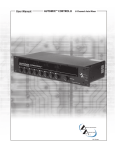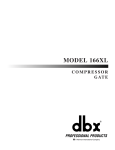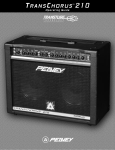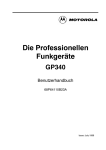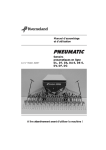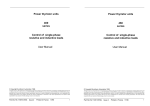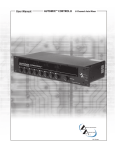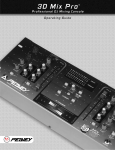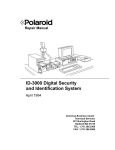Download Peavey Automix2 User's Manual
Transcript
2 AUTOMIX ™ 8 Channel Automatic Mixer OPERATING GUIDE Intended to alert the user to the presence of uninsulated Òdangerous voltageÓ within the productÕs enclosure that may be of sufficient magnitude to constitute a risk of electric shock to persons. Intended to alert the user of the presence of important operating and maintenance (servicing) instructions in the literature accompanying the product. CAUTION: Risk of electrical shock Ñ DO NOT OPEN! CAUTION: To reduce the risk of electric shock, do not remove cover. No user serviceable parts inside. Refer servicing to qualified service personnel. WARNING: To prevent electrical shock or fire hazard, do not expose this appliance to rain or moisture. Before using this appliance, read the operating guide for further warnings. Este s’mbolo tiene el prop—sito, de alertar al usuario de la presencia de Ò(voltaje) peligrosoÓ que no tiene aislamiento dentro de la caja del producto que puede tener una magnitud suficiente como para constituir riesgo de corrientazo. Este s’mbolo tiene el prop—sito de alertar al usario de la presencia de instruccones importantes sobre la operaci—n y mantenimiento en la literatura que viene con el producto. PRECAUCION: Riesgo de corrientazo Ñ ÁNo abra! PRECAUCION: Para disminu’r el riesgo de corrientazo, no abra la cubierta. No hay piezas adentro que el usario pueda reparar. Deje todo mantenimiento a los tŽcnicos calificados. ADVERTENCIA: Para evitar corrientazos o peligro de incendio, no deje expuesto a la lluvia o humedad este aparato Antes de usar este aparato, Iea m‡s advertencias en la gu’a de operaci—n. Ce symbole est utilisŽ pur indiquer ˆ lÕutilisateur la prŽsence ˆ lÕintŽrieur de ce produit de tension nonisolŽe dangereuse pouvant •tre dÕintensitŽ suffisante pour constituer un risque de choc Žlectrique. Ce symbole est utilisŽ pour indiquer ˆ lÕutilisateur quÕil ou quÕelle trouvera dÕimportantes instructions sur lÕutilisation et lÕentretien (service) de lÕappareil dans la littŽrature accompagnant le produit. ATTENTION: Risques de choc Žlectrique Ñ NE PAS OUVRIR! ATTENTION: Afin de rŽduire le risque de choc Žlectrique, ne pas enlever le couvercle. Il ne se trouve ˆ lÕintŽrieur aucune pi•ce pouvant •tre reparŽe par lÕutilisateur. Confier IÕentretien ˆ un personnel qualifiŽ. AVERTISSEMENT: Afin de prŽvenir les risques de dŽcharge Žlectrique ou de feu, nÕexposez pas cet appareil ˆ la pluie ou ˆ lÕhumiditŽ. Avant dÕutiliser cet appareil, lisez les avertissements supplŽmentaires situŽs dans le guide. Dieses Symbol soll den Anwender vor unisolierten gefŠhrlichen Spannungen innerhalb des GehŠuses warnen, die von Ausreichender StŠrke sind, um einen elektrischen Schlag verursachen zu kšnnen. Dieses Symbol soll den Benutzer auf wichtige Instruktionen in der Bedienungsanleitung aufmerksam machen, die Handhabung und Wartung des Produkts betreffen. VORSICHT: Risiko Ñ Elektrischer Schlag! Nicht šffnen! VORSICHT: Um das Risiko eines elektrischen Schlages zu vermeiden, nicht die Abdeckung enfernen. Es befinden sich keine Teile darin, die vom Anwender repariert werden kšnnten. Reparaturen nur von qualifiziertem Fachpersonal durchfŸhren lassen. ACHTUNG: Um einen elektrischen Schlag oder Feuergefahr zu vermeiden, sollte dieses GerŠt nicht dem Regen oder Feuchtigkeit ausgesetzt werden. Vor Inbetriebnahme unbedingt die Bedienungsanleitung lesen. 2 ENGLISH AUTOMIXª 2 INTRODUCTION Thank you for purchasing the Automixª 2! The Architectural Acoustics Automixª 2 is a high quality automatic mixer with eight transformer balanced mic/line inputs. Each channel provides a gain control, 48 Volt phantom power (mic inputs), low cut filter, activity/clipping LED, an Aux send control and a choice between manual or automatic operation. Each channel also provides a defeatable insert point, 5 Volt TTL status output and can be muted individually or multiple channels can be muted simultaneously via an assignable mutebus. In addition, channels one and two provide an adjustable priority control. The master section provides a gain trim control, three 1/9 octave sweepable notch filters, a downward expander, transformer balanced outputs (main and aux) and remote volume connections. The Automixª 2 has been designed to easily link multiple units together to form a single mixer with many more inputs (16, 24, 32...). The Automix 2 is supplied with a see-through plexiglass security panel to prevent changes to the installerÕs settings. THEORY OF OPERATION FRONT PANEL 1 2 FRONT PANEL FEATURES 1. CHANNEL LEVEL Manual Mode: In the manual mode the channel level controls provide 6dB of gain and 50dB of attenuation. Auto Mode: In the auto mode the control still provides 50dB of attenuation, but the control does not add gain to the overall system level. Instead, when the level is adjusted above Ò0Ó, the other channels are attenuated to make the channel being adjusted sound louder in the mix without adding to the system gain. 2. MASTER LEVEL The master level controls the overall output level. The range is set for 10dB of gain above, and 40dB of attenuation. 3 INTERNAL PANEL 8 3 9 12 10 13 11 4 5 6 7 INTERNAL PANEL FEATURES 3. DIP SWITCHES Each channel has four DIP switches that control the following functions. A. MAN/AUTO This switch determines whether the channel is operating in the automatic or manual mode. B. OFF/MBUS This switch is used to connect the channel to the system mutebus. This allows multiple inputs to be muted simultaneously under external control. See MUTEBUS, page 7. C. LO CUT/FLAT This switch selects the low cut filter. The low cut filter provides a low frequency rolloff that will help minimize unwanted noise (handling of mics, bumping of table, etc...). The rolloff starts at 100 Hz (-3dB) and is a 6dB per octave filter. D. OFF/+48 When this switch is in the +48 position, +48 volts of phantom power is supplied to the mic ± terminals. This provides power for condenser mics and should be defeated when using dynamic microphones or unbalanced inputs. 4. AUX SEND CONTROL Controls the level of the signal being sent to the AUX bus. The level being sent to the Aux bus will also be affected if the gain control in that channel is changed. 5. GAIN TRIM This control sets the input gain in each channel. The amount of gain is adjustable from +25dB to +60dB. (Mic input.) 6. ACTIVITY/CLIPPING LED ACTIVITY In the automatic mode the LED will glow green, indicating the channel that is predominant in the mix (auto mode). If the channel is in the manual mode the LED will stay on if the front panel level control is at or above the 12:00 position. The green LED is also an indication of the status output state. If the LED is on, then the status output will be high (+5 Volts). If the LED is off, then the status output will be low (0 Volts). CLIPPING The LED will turn red if the channel is within 1dB of clipping. 4 7. PRIORITY (CHANNEL 1 and 2 ONLY) Turning the priority control clockwise allows one channel to override the others in the mix. It does this by ÒtrickingÓ the gain computing circuits into thinking this channel is louder than the others. Up to 9dB of priority is available. 8. AUX MASTER LEVEL CONTROL This control sets the level of the signal being sent to the Aux Out. This level should be set after the individual channel levels have been set. 9. DOWNWARD EXPANDER The downward expander can be used to attenuate the system gain when all of the input signals are low. This can be used to prevent background room noise from being amplified. SETTING THE DOWNWARD EXPANDER Have someone speak into a microphone at the softest level you can expect to encounter. Slowly turn the downward expander clockwise until the background noise between words is attenuated. Be careful not to go too far. The more downward expander that is used, the less ÒnaturalÓ sounding the system will become. This method will give you a good starting point, but the best way to set the downward expander is during an actual meeting or event. While doing this, the downward expander can be adjusted for the best sound. If you have to deal with both loud and quiet events, you will need to trade off between natural sounding ambient and background noise. 10. MASTER GAIN TRIM This control sets the maximum overall system gain and should be set with the front panel master gain set to the full clockwise position, all channels at unity, and external power amps turned up and locked at operational settings. When trimmed to a safe margin below feedback, no combination of user controls can cause feedback. This trim provides up to 25dB of attenuation of the system gain. 11. NOTCH FILTER LEVEL CONTROL The notch filter level control adjusts the amount of cut at the frequency selected by the corresponding frequency control (12). It is adjustable from 0dB to 15dB of cut. 12. NOTCH FILTER FREQUENCY CONTROL The notch filter frequency control is used to select the center frequency of the notch filter. The bottom filter has a range of 40Hz to 925Hz. The middle filter has a range of 260Hz to 6kHz. The upper filter has a range of 500Hz to 12kHz. 13. POWER LED Indicates that AC mains power power is connected and power switch is in the ÒONÓ position. 5 24 23 18 22 19 17 15 16 25 20 14 21 BACK PANEL FEATURES 14. MIC INPUTS For use with low impedance microphones or low level sources. This is a transformer balanced input with an impedance of 2,000½. Input sensitivity for nominal output is -56dBu to -19dBu. LINE INPUTS These allow line level inputs to be used. This is a transformer balanced input through a 30dB resistive pad. Input impedance is >20k½. 15. INSERT IN/OUT This is a signal loop that allows an external device such as an EQ to be inserted into the signal path of individual channels (refer to diagram below). Insert In/Out IN +-G OUT G-+ CEQ 280a 16. INSERT BYPASS SWITCH When no signal processor is being used or bypassing the signal processor is desired, this switch should be in the ÒinÓ position. If a signal processor is being used, then this switch should be in the ÒoutÓ position. 17. DIRECT OUTPUTS Each channel has direct output terminals that can be used for recording or anytime the output of an individual channel is required. This signal is independent of ÒAutomixÓ gain manipulation. The nominal output level is 2.21dBu (1 Volt). 6 MUTE Channels can be muted individually by shorting this terminal to ground. It provides approximately 45dB of attenuation. Mute with External Switch STATUS OUTPUT The status output is a DC logic output that is high (+5 Volts) when the channel is active and low (0Volts) when the channel is not active. This DC voltage can be used to key video cameras or trigger key lights on active microphones. NOTE: Each channel can source a maximum of 10 mA. 18. MAIN OUT The main output is a 600½, transformer balanced output that can be used to feed an external power amplifier. It is at this point the automatically mixed or the manually mixed output is accessed. The nominal output is 2.21 dBu (1 volt). 19. AUX OUT The aux output is a 600½, transformer balanced output that can be used as an additional non-automixed output. The nominal output is 2.21 dBu (1 volt). 20. REMOTE VOLUME The master level of the mixer can be controlled remotely with a simple connection on the back of the unit. A 10k pot will provide approximately 0 to 25dB of attenuation. A 100k pot will provide 0 to 45dB of attenuation. If desired, a control voltage can be inserted to command 0 to 70dB of attenuation. The internal gain trim must be set full clockwise to achieve the maximum attenuation range of the remote volume (refer to diagram below). NOTE: THE CONTROL VOLTAGE SHOULD NEVER EXCEED 13 VOLTS DC. Mute Bus Remote Volume 7 21. 22. MUTEBUS The mutebus is a control port that when shorted to ground will mute all channels that are assigned to the mutebus approximately 45dB. The channels to be muted must be assigned to the mutebus using the internal switch marked OFF/MBUS. See INTERNAL PANEL FEATURES, page 4 and diagram page 7. LINK PORT To increase the number of inputs available, multiple Automixers can be linked together. Linking automixers is a very simple process. It can be done with a small flat-head screwdriver and a short length of four conductor shielded wire. The following diagram and procedures will ensure proper linking. Link Port 1. 2. 3. 23. 24. 25. Make a linking cable. Connect the mixers according to the diagram above. Select the mixer to be used as the master and place its link switch in the ÒmasterÓ position. 4. All other mixers in the system should have their link switches in the ÒslaveÓ position. You now have a 16 (or more) channel automatic mixer. The master controls of the unit chosen as ÒmasterÓ should be used to control the system. LINK SWITCH The link switch is used to place the unit in the master or slave mode of operation. A standalone unit should always be in the master mode. See Link Port (#22). POWER SWITCH Switch to ÒIÓ position to turn on. IEC INLET (AC) With the Power Switch in the off (O) position, plug the power cord into this connector prior to plugging into your AC power source. Always ensure proper AC voltage and grounding practices are utilized (proper voltage is labeled under inlet). NOTE: FOR UK ONLY As the colors of the wires in the mains lead of this apparatus may not correspond with the colored markings identifying the terminals in your plug, proceed as follows: (1) The wire which is colored green and yellow must be connected to the terminal which is marked by the letter E or by the earth symbol or colored green or green and yellow. (2) The wire which is colored blue must be connected to the terminal which is marked with the letter N or the color black. (3) The wire which is colored brown must be connected to the terminal which is marked with the letter L or color red. 8 AUTOMIXª 2 SPECIFICATIONS Nominal Out = 2.21 dBu = 1 Volt Input Specifications: Function Input z (ohms) Min Input Gains Setting Microphone (150 ohms) 2k Max Gain (60dB) Line (10K ohms) >20k Min* Max Gain (30dB) Input Levels (to bal. outputs) Nominal** Bal./ Unbal. Connector Max -64dBu (0.5mV) -43dBu (5.5mV) -2dBu (615mV) Bal. Mic In (+) Mic In (-) Ground -35dBu 13.7mV -14dBu (155mV) +27dBu (17.4V) Bal. Line In (+) Line In (-) Ground * Minimum input level (Sensitivity) is the smallest signal that will produce nominal output (2.21dBu) with channel and master controls set for maximum gain. ** Nominal settings are defined s all control set at 0 dB (or 50% rotation for rotary pots. EIN: Phantom Power: Priority (Channels 1 and 2): Low Cut Filter: Common Mode: Rejection Ratio: -122dBu (Max gain, terminated 150 Ohms) +48 Volts at Mic ± terminated 0dB to 9dB -3dB at 100Hz (6dB per octave) >65dB at 20Hz Ñ 20kHz >85dB @ 1kHz Output Specifications: Function Main Out Minimum Load Z (Ohms) Output Levels Nominal 600 +2.21dBu +20dBu +16dBm (1V) (7.75V) (6.44V) Bal./ Unbal. Connector Main Out (=) Bal. Main Out (+) Max Main Out (-) (Hi Z load) (600½ load) Aux Out 600 +2.21dBu +20dBu (1V) (Hi Z load) +16dBm (600½ load) Ground Bal. Aux Out (+) Aux Out (-) Ground Distortion: Mic Input to Main Output: <0.2% at nominal (20Hz to 20kHz) Frequency Response: Mic Input Main Output: Mic Input to Aux Output: 20Hz to 20kHz +0/-1 dB at nominal 20Hz to 20kHz +0/-1 dB at nominal 9 AUTOMIXª 2 SPECIFICATIONS Hum and Noise: Output Residual Noise Ref: 0 dBu Main Out S/N Ratio Ref: 2:21 dBu Test Conditions -85dBu 87dB All controls down -84dBu 86dB One channel nominal, Master level nominal -85dBu 87dB All controls down -80dBu 82dB One channel send nominal,Monitor master nominal Aux Out (Hum and noise measurements: 22 Hz to 22 kHz BW) GENERAL SPECS: Remote volume range: 0dB to 70dB of attenuation Off channel attenuation: 0dB to 70dB Mute: Channel is attenuated 45dB when Mute to ground connection is made. MuteBus: Multiple channels can be attenuation 45dB when MuteBus to ground connection is made. Status output: Status is high (5V) when channel is active. It is low (0V) when channel is not active. Power consumption: AC 120 Volts, 60Hz, Domestic AC 230 Volts, 50/60 Hz Export 15 watts Weight: 11 pounds Dimensions: Width: 19 inches Depth: 9 1/4 inches Height: 3 1/2 inches 10 AUTOMIXª 2 Setting up the Automixª 2 1. Wiring Inputs and Outputs: For best results, it is recommended that two-conductor shielded cable is used for all input and output connections. When making connections remember to observe proper polarity. The recommended strip length for the detachable screw terminals is 1/2". 2. Initial Control Settings: Channel Levels Channel Gain Trims Aux Send Controls Priority Notch Controls Downward Expander Aux Master Level Master Level Master Gain Trim All channels in the ÒautoÓ 3. (Faceplate) (Internal) (Internal) (Internal) (Internal) (Internal) (Internal) (Faceplate) (Internal) mode Ñ Ñ Ñ Ñ Ñ Ñ Ñ Ñ Ñ Full Full Full Full Full Full Full Full Full CCW CCW CCW CCW CCW CCW CCW CW CCW Setting the Channel Level: Set the front panel control (of the channel that is being adjusted) to the middle (12 oÕclock) position. Connect a mic or line input to the first channel. While someone is speaking into the mic (in a way that it would normally be used), slowly increase the channel gain trim until a slight ringing (feedback) is heard or until the clip led begins to blink red occasionally. Turn the channel gain trim down slowly until the ringing is no longer audible. This is the maximum level that the gain trim should be set. Turn the external channel level control down (full CCW). NOTE: The internal master gain trim (#10) may need to be turned up (CW) if the channels can be easily driven into clipping, or feedback cannot be obtained in the normal operating range of the internal gain trim control. Repeat this step for the remaining channels. Return all of the external channel levels controls to their mid position (12 oÕclock). 4. Setting the Notch Filter: The notch filter can be set in a couple of ways. It can be set using test equipment to pinpoint frequencies that are prone to feedback, or it can be set Òby ear.Ó For the purpose of this manual, the Òby earÓ method will be described: A. B. C. D. Slowly increase the master gain trim (internal) until a slight ringing is audible. Select the proper frequency range and turn the corresponding level control CW to about the 12 oÕclock position. Slowly turn the frequency control back and forth until the ringing is no longer audible. Again, slowly increase the master gain trim until ringing is heard. If this is a different frequency, repeat steps B and C. If it is not a different frequency, try turning the frequency control while listening to the feedback. Stop when the feedback is as low as possible. If the feedback is still audible, turn the corresponding level control CW toward the -15 setting until the feedback is gone. 11 5. Setting the Overall Level: Set the master level control (external) for the desired overall output level. This mixerÕs levels are now set and the mixerÕs other features (downward expander, low cut and priorities) can be set as desired for the application. 6. Attaching the Security Panel: Attach the security plexiglass with the eight supplied screws. This will prevent any unwanted tampering with the settings. 12 ESPA„OL AUTOMIXª 2 INTRODUCCIîN ÁLe agradecemos haber adquirido el Automixª 2! El Architectural Acoustics Automixª 2 es un mezclador autom‡tico de alta calidad, con ocho entradas de micr—fono/l’nea equilibradas por transformador. Cada canal posee control de ganancia, alimentaci—n fantasma de 48 V (entradas de micr—fono), filtro de corte de bajos, LED indicador de actividad/recorte de se–al, control de se–al de muestra auxiliar y la opci—n de operaci—n manual o autom‡tica. Cada canal tambiŽn posee un punto de inserci—n anulable y salida de estado de l—gica TTL (5 V). Se puede silenciar individualmente o simult‡neamente con varios canales, mediante un bus de silenciado asignable. Adem‡s, los canales 1 y 2 tienen control de prioridad ajustable. La secci—n maestra provee un control de recorte de ganancia, tres filtros de muesca con barrido de frecuencia de 1/9 de octava, un expansor descendente, salidas equilibradas por transformador (principal y auxiliar) y conexiones para control de volumen remoto. El mezclador Automixª 2 ha sido dise–ado para interconectar f‡cilmente entre s’ varias unidades y formar un œnico mezclador con muchas m‡s salidas (16, 24, 32É). Para evitar modificaciones a las configuraciones del instalador, el mezclador Automix 2 se suministra con un panel de seguridad de plexiglas transparente. Consulte los diagramas del panel delantero en la secci—n de inglŽs de est manual. TEORêA DE OPERACIîN FUNCIONES DEL PANEL FRONTAL 1. NIVEL DE CANAL Modo manual: En el modo manual, los controles de nivel de canal proveen 6 dB de ganancia y 50 dB de atenuaci—n. Modo autom‡tico: En modo autom‡tico el control aœn provee 50 dB de atenuaci—n, pero no agrega ganancia al nivel general del sistema. En lugar de ello, cuando el nivel se ajusta por arriba de Ò0Ó, los otros canales se atenœan para hacer que el canal ajustado predomine en la mezcla con mayor intensidad sonora, sin aumentar la ganancia del sistema. 2. NIVEL MAESTRO El nivel maestro controla el nivel de salida general. La banda est‡ configurada para 10 dB de ganancia positiva y 40 dB de atenuaci—n. FUNCIONES DEL PANEL INTERNO 3. INTERRUPTORES DIP Cada canal tiene cuatro interruptores DIP que controlan las siguientes funciones: A. MANUAL/AUTOMçTICO Este conmutador determina si el canal funciona en modo manual o en modo autom‡tico. B. DESACTIVADO/BUS DE SILENCIADO Este interruptor se utiliza para conectar el canal al bus de silenciado del sistema. Esto 13 permite que varias entradas se silencien simult‡neamente mediante un control externo. Vea BUS DE SILENCIADO en la p‡gina 7. C. CORTE DE BAJOS/PLANO Este conmutador selecciona el filtro de corte de bajos. El filtro de corte de bajos provee atenuaci—n progresiva de baja frecuencia, que ayuda a minimizar los ruidos no deseados (movimiento de micr—fonos, golpes en la mesa, etc.). La atenuaci—n progresiva comienza a 100 Hz (Ð3 dB). Es un filtro de 6 dB por octava. D. DESACTIVADO/+48 Cuando este interruptor est‡ en la posici—n +48, se suministran +48 V de alimentaci—n fantasma a los terminales ± del micr—fono. Esto provee alimentaci—n para los micr—fonos electrost‡ticos. Se debe desactivar al utilizar micr—fonos din‡micos o entradas no equilibradas. 4. CONTROL DE SE„AL DE MUESTRA AUXILIAR Controla el nivel de la se–al enviada al bus auxiliar. El nivel enviado al bus auxiliar tambiŽn es afectado si se modifica el control de ganancia del canal. 5. RECORTE DE GANANCIA Este control configura la ganancia de entrada a cada canal. La cantidad es ajustable de +25 a +60 dB (entrada de micr—fono). 6. LED ACTIVIDAD/RECORTE DE SE„AL En el modo autom‡tico, el LED indicador se enciende de color verde para indicar que el canal es el predominante en la mezcla (modo autom‡tico). Si el canal est‡ en modo manual, el LED indicador continœa encendido si el control de nivel del panel frontal est‡ en la posici—n de las 12:00 horas o m‡s all‡. El LED indicador verde tambiŽn es un aviso del estado de la salida: si est‡ encendido, el estado de la salida es alto (+5 V); si est‡ apagado, el estado es bajo (0 V). RECORTE DE SE„AL Si el canal est‡ a 1 dB o menos del recorte de la se–al, el LED indicador se enciende de color rojo. 7. PRIORIDAD (SîLO EN LOS CANALES 1 y 2) Al girar el control de prioridad hacia la derecha, se permite que el canal predomine sobre los otros en la mezcla. Para ello, Òenga–aÓ a los circuitos de c—mputo de ganancia haciŽndolos creer que este canal tiene mayor intensidad sonora que los otros. Se dispone de hasta 9 dB de prioridad. 8. CONTROL DE NIVEL MAESTRO AUXILIAR Este control configura el nivel de la se–al que se env’a a la salida auxiliar. El nivel se debe graduar despuŽs de configurar los niveles individuales de los canales. 9. EXPANSOR DESCENDENTE El expansor descendente se puede utilizar para atenuar la ganancia del sistema cuando todas las se–ales de entrada son bajas. Esto se puede aprovechar para evitar que el ruido ambiente de fondo sea amplificado. 14 CONFIGURACIîN DEL EXPANSOR DESCENDENTE Pida a otra persona que hable frente a un micr—fono al nivel m‡s bajo que se espera utilizar. Gire lentamente el expansor descendente hacia la derecha, hasta que se atenœe el ruido ambiente de fondo entre las palabras. Tenga cuidado de no excederse. Cuanto m‡s expansor descendente se utilice, menos "natural" ser‡ el sonido del sistema. Este mŽtodo brinda un buen punto de partida para el ajuste, pero la mejor manera de configurar el expansor descendente es durante la actuaci—n o evento real. Esto permite ajustar el expansor descendente para obtener el mejor sonido. Si debe trabajar con eventos muy ruidosos o muy silenciosos, deber‡ lograr un equilibrio entre el sonido natural y la anulaci—n del ruido ambiente. 10. RECORTE DE GANANCIA MAESTRO Este control establece la m‡xima ganancia general del sistema y se debe configurar con el control de ganancia maestro del panel frontal girado totalmente a la derecha y el amplificador externo activado, con los controles fijos en la configuraci—n operacional. Al recortar la ganancia a un nivel seguro por debajo de la retroalimentaci—n, ninguna combinaci—n de controles del usuario podr‡ generar esa perturbaci—n. El control de recorte de se–al provee hasta 25 dB de atenuaci—n de ganancia del sistema. 11. CONTROL DE NIVEL DE FILTRO DE MUESCA El control de nivel de filtro de muesca ajusta la magnitud de recorte a la frecuencia seleccionada mediante el correspondiente control de frecuencia (12). El recorte es ajustable de 0 a 15 dB. 12. CONTROL DE FRECUENCIA DE FILTRO DE MUESCA El control de frecuencia de filtro de muesca se utiliza para seleccionar la frecuencia central del filtro. El filtro inferior tiene una banda de 40 a 925 Hz; el filtro central tiene una banda de 260 Hz a 6 kHz; el filtro superior tiene una banda de 500 Hz a 12 kHz. 13. LED DE ALIMENTACIîN Indica que la alimentaci—n de l’nea de CA est‡ conectada y que el interruptor de alimentaci—n est‡ activado. 24 23 22 18 19 17 15 16 25 20 14 21 FUNCIONES DEL PANEL POSTERIOR 14. ENTRADAS DE MICRîFONO Para utilizar con micr—fonos de baja impedancia o fuentes de bajo nivel. Es una entrada equilibrada por transformador, con una impedancia de 2000 ½. La sensibilidad de la entrada para la salida nominal es de Ð56 a Ð19 dBu. 15 ENTRADAS DE LêNEA Permiten utilizar entradas con nivel de l’nea. Son entradas equilibradas por transformador a travŽs de un atenuador resistivo de 30 dB. La impedancia de entrada es >20 k½. 15. ENTRADA/SALIDA DE INSERCIîN Es un circuito de se–al que permite insertar un dispositivo externo, tal como un ecualizador, en el camino de la se–al de los canales individuales (consulte el diagrama m‡s abajo). Insert In/Out IN +-G OUT G-+ CEQ 280a 16. INTERRUPTOR DE DERIVACIîN DE SE„AL Cuando no se utiliza ningœn procesador de se–al o se desea evitar el procesador de se–al, este interruptor debe estar hacia adentro. Si se utiliza un procesador de se–al, debe estar afuera. 17. SALIDAS DIRECTAS Cada canal tiene terminales de salida directa que se pueden utilizar para grabaci—n o cuando se necesite la salida de un canal individual. La se–al es independiente de la ganancia del mezclador Automixª 2. El nivel de salida nominal es 2,21 dBu (1 V). SILENCIADO DE SONIDO Los canales se pueden silenciar individualmente conectando este terminal a tierra. Provee aproximadamente 45 dB de atenuaci—n. Mute with External Switch 16 ESTADO DE SALIDA El estado de la salida es una salida l—gica de CC que est‡ en condici—n alta (+5 V) cuando el canal est‡ activo, y baja (0 V) cuando est‡ inactivo. El voltaje de CC se puede utilizar para excitar videoc‡maras o disparar luces indicadoras en micr—fonos activos. NOTA: Cada canal puede generar un m‡ximo de 10 mA. 18. SALIDA PRINCIPAL Es una salida de 600 ½ equilibrada por transformador, que se puede utilizar con un amplificador de potencia externo. ƒste es el punto en que se accede a la salida mezclada autom‡tica o manualmente. La salida nominal es 2,21 dBu (1V). 19. SALIDA AUXILIAR Es una salida de 600 ½ equilibrada por transformador, que se puede utilizar como una salida adicional no mezclada autom‡ticamente. La salida nominal es 2,21 dBu (1V). 20. VOLUMEN REMOTO El nivel maestro puede ser controlado a distancia con una simple conexi—n en la parte posterior de la unidad. Un potenci—metro de 10 k½ provee aproximadamente 0 a 25 dB de atenuaci—n, en tanto que un potenci—metro de 100 k½ provee de 0 a 45 dB. Si se desea, se puede insertar un voltaje de control para controlar la atenuaci—n de 0 a 70 dB. El recorte de ganancia interno debe estar configurado completamente hacia la derecha, para lograr la gama de atenuaci—n m‡xima del volumen remoto (consulte el diagrama m‡s abajo). NOTA: EL VOLTAJE DE CONTROL NO DEBE NUNCA EXCEDER 13 VCC. Mute Bus Remote Volume 21. BUS DE SILENCIADO EL bus de silenciado es un puerto de control que, cuando se conecta a tierra, silencia 45 dB aproximadamente en todos los canales asignados. Los canales a silenciar se asignan al bus de silenciado utilizando el interruptor interno ÒOFF/MBUSÓ (desactivado/bus de silenciado). Consulte las FUNCIONES DEL PANEL INTERNO en la p‡gina 4 y el diagrama de la p‡gina 7. 22. PUERTO DE ENLACE Para aumentar la cantidad de entradas disponibles, se pueden interconectar entre s’ varios mezcladores Automix, mediante un procedimiento muy sencillo. S—lo se requiere un destornillador de punta plana peque–o y un tramo corto de cable blindado de cuatro conductores. El diagrama y los procedimientos que siguen aseguran un enlace apropiado. 17 Link Port 1. 2. 3. Prepare un cable de enlace. Conecte los mezcladores segœn el diagrama de m‡s arriba. Seleccione el mezclador a ser utilizado como maestro y coloque su conmutador de enlace en la posici—n ÒmasterÓ (maestro). 4. Todos los otros mezcladores del sistema deben tener sus conmutadores de enlace en la posici—n ÒslaveÓ (esclavo). Ahora usted cuenta con un mezclador autom‡tico de 16 canales o m‡s. Los controles maestros de la unidad elegida como "maestra" se utilizar‡n para controlar el sistema. 23. CONMUTADOR DE ENLACE El conmutador de enlace se utiliza para colocar la unidad en el modo de operaci—n maestro o en el modo esclavo. Siempre debe haber una unidad aut—noma en el modo maestro. Consulte PUERTO DE ENLACE (N¼ 22). 24. INTERRUPTOR DE ALIMENTACIîN Para encender el equipo, col—quelo en ÒIÓ. 25. RECEPTçCULO DE ENTRADA IEC (CA) Con el interruptor de alimentaci—n en la posici—n de apagado (ÒOÓ), enchufe el cable de alimentaci—n en este conector antes de enchufarlo en la fuente de alimentaci—n de CA. Asegœrese de utilizar siempre voltaje de CA y pr‡cticas de conexi—n a tierra apropiados. (El voltaje adecuado est‡ indicado bajo el recept‡culo.) 18 FRAN‚AIS AUTOMIXª 2 INTRODUCTION Nous vous fŽlicitons pour lÕachat de cet Automixª 2. LÕAutomixª 2 Architectural Acoustics est un mixeur automatique haute qualitŽ possŽdant huit entrŽes micro/ligne symŽtriques (transformateur). Chaque canal poss•de un contr™le de gain, une alimentation phantom 48 Volt (entrŽes micro), une filtre coupe-bas, une LED dÕactivitŽ/Žcr•tage, un contr™le Aux send et le choix entre une opŽration manuelle ou automatique. Chaque canal est par ailleurs ŽquipŽ dÕun insert assignable, dÕune sortie ÒstatutÓ 5 Volt TTL et peut •tre rendu muet individuellement ou en groupe gr‰ce ˆ un bus Mute. De plus, les canaux 1 et 2 disposent dÕun contr™le de prioritŽ ajustable. La section master poss•de un contr™le de gain, trois notch filters 1/9 dÕoctave ˆ frŽquence rŽglable, un expandeur, des sorties symŽtrisŽes par transformateur (main et aux) et des connexions pour le contr™le de volume ˆ distance. LÕAutomixª 2 a ŽtŽ con•u pour •tre reliŽ ˆ dÕautres unitŽs afin de constituer un mixeur possŽdant un plus grand nombre dÕentrŽes (16, 24, 32...). Il est par ailleurs ŽquipŽ dÕun panneau plexiglass transparent afin dÕŽviter toute modification accidentelle des rŽglages de lÕinstallateur. Veuillez-vous rŽfŽrer au<<front panel>> art situŽ dans la section en langue anglaise de ce manual. PANNEAU AVANT CONTROLES DU PANNEAU AVANT 1. NIVEAU DU CANAL Mode Manuel: Dans ce mode, les contr™les de niveau permettent un contr™le de gain de +6dB ˆ -50dB. Mode Automatique: En mode Automatique, le contr™le fournit toujours jusquÕˆ 50dB dÕattŽnuation mais nÕaugmentera pas le gain du canal. Cependant, lorsquÕil est rŽglŽ au dessus de Ò0Ó, le gain des autres canaux est attŽnuŽ afin de rendre le canal concernŽ plus fort dans le mix mais sans augmenter le gain gŽnŽral. 2. NIVEAU MASTER Il contr™le le niveau gŽnŽral de sortie. Sa plage de rŽglage sÕŽtend de +10dB ˆ -40dB. CONTROLES DU PANNEAU INTERNE 3. DIP SWITCHS Chaque canal poss•de quatre DIP switchs gŽrant les fonctions suivantes. A. MAN/AUTO Ce sŽlecteur dŽtermine le mode du canal: automatique ou manuel. B. OFF/MBUS Ce sŽlecteur connecte le canal au bus Mute . Cela permet de rendre muets plusieurs canaux simultanŽment gr‰ce ˆ un contr™le externe. Voir MUTEBUS, page 7. 19 C. LO CUT/FLAT Ce sŽlecteur actionne le filtre coupe-bas. Ce filtre attŽnue les frŽquences graves afin de minimiser les bruits indŽsirables (manipulation du micro, etc...). La frŽquence de coupure est fixŽe ˆ 100 Hz (-3dB) et la pente du filtre est de 6dB par octave. D. OFF/+48 Lorsque ce sŽlecteur est en position +48, une alimentation Phantom de +48 Volt est prŽsente aux bornes + et - de lÕentrŽe micro. Cela permet lÕalimentation des micros passifs mais devra •tre dŽsactivŽ lors de lÕutilisation de micros dynamiques ou asymŽtriques. 4. CONTRïLE AUX SEND DŽtermine le niveau du signal envoyŽ au bus AUX. Ce niveau sera par ailleurs affectŽ par le contr™le de gain du canal correspondant. 5. GAIN DŽtermine le gain dÕentrŽe. La plage de rŽglage sÕŽtend de +25dB ˆ +60dB (entrŽe Micro) 6. LED DÕƒCRæTAGE/ACTIVITƒ En mode automatique, la LED sÕallumera en vert pour indiquer quel canal est prŽdominant dans le mix (mode auto). Si le canal est en mode manuel, la LED restera allumŽe si le contr™le de niveau du paneau avant est rŽglŽ au dessus de 12h00. La LED indique par ailleurs lÕŽtat du canal concernŽ: si elle sÕallume (+5 Volt), un signal est prŽsent; si elle est Žteinte (0 Volts), alors aucun signal nÕest prŽsent. ECRæTAGE La LED sÕallumera en rouge si le canal est ˆ 1dB de son point dÕŽcr•tage. 7. PRIORITƒ (CANAUX 1 ET 2 UNIQUEMENT) En tournant le contr™le dans le sens horaire, le canal concernŽ devient prŽdominant dans le mix. JusquÕˆ 9 dB de gain sont disponibles. 8. CONTRïLE DE NIVEAU MASTER AUX Ce contr™le dŽtermine le niveau du signal envoyŽ ˆ la sortie Aux Out. Ce contr™le doit •tre ajustŽ aprŽs que les niveaux individuels des canaux aient ŽtŽ rŽglŽs. 9. EXPANDEUR LÕexpandeur permet de diminuer le gain des canaux lorsque leurs signaux sont bas. Ceci permet de ne pas amplifier les bruits de fond. RƒGLAGE DE LÕEXPANDEUR EXPANDEUR Parlez dans le micro au niveau le plus faible nŽcessitant dÕ•tre entendu ˆ travers le syst•me . Tournez lentement le contr™le de lÕexpandeur dans le sens des aiguilles dÕune montre jusquÕˆ ce que le bruit de fond prŽsent entre les paroles dispara”sse. Ne poussez pas ce contr™le trop loin. Plus lÕexpandeur est sollicitŽ, moins le rŽsultat sera naturel. Cette mŽthode vous donne un bon point de dŽpart mais la meilleure mani•re de rŽgler lÕexpandeur est de le faire en situation. LÕexpandeur sera ainsi ajustŽ pour le meilleur rendu possible. Si il doit •tre utilisŽ dans des applications bruyantes, il vous faudra trouver un Žquilibre entre bruit ambient et bruit de fond. 10. GAIN MASTER Ce contr™le dŽtermine le gain gŽnŽral du syst•me et doit •tre rŽglŽ avec le gain master du 20 panneau avant sur sa position maximum, tous les canaux au niveau nominal et les amplificateurs de puissance en marche et ˆ leur niveau dÕutilisation normale. Lorsque le niveau est Žtabli en dessous du niveau de feedback, aucune manipulation en face avant nÕentra”nera de larsen. Ce rŽglage permet jusquÕˆ 25dB dÕattŽnuation du gain du syst•me. 11. NIVEAU DU NOTCH FILTER Ce rŽglage dŽtermine lÕintensitŽ de la coupure du filtre ˆ la frŽquence sŽlectionnŽe par le contr™le n¡12. Il est ajustable de 0dB ˆ 15dB de coupure. 12. FRƒQUENCE DU NOTCH FILTER Ce contr™le permet de dŽterminer la frŽquence centrale du notch filter. La frŽquence de centrage du filtre Graves peut varier de 40Hz ˆ 925Hz, celle du filtre MŽdiums de 260Hz ˆ 6kHz et celle du filtre Aigus de 500Hz ˆ 12kHz. 13. LED DÕALIMENTATION Indique que lÕappareil est branchŽ et que lÕinterrupteur de mise sous tension est en position ÒONÓ. 24 23 22 18 19 17 15 16 25 20 21 14 CONTROLES DU PANNEAU ARRIéRE 14. ENTRƒES MICRO Cette entrŽe est destinŽe aux micros basse impŽdance et aux sources ˆ faible niveau. Ces entrŽes sont symŽtrisŽes par transformateur est poss•dent une impŽdance dÕentrŽe de 2 k½. Un niveau dÕentrŽe de -56dBu ˆ -19dBu produit un niveau de sortie nominal. ENTRƒES LIGNES Elles permettent lÕutilisation de source au niveau ligne. Ces entrŽes sont symŽtrisŽes par transformateur est ŽquipŽe dÕun attŽnuateur de 30dB. Leur impŽdance dÕentrŽe est supŽrieure ˆ 20k½. 15. INSERT IN/OUT Cette boucle permet dÕinsŽrer dans un canal un processeur externe tel un Žqualiseur (reportez-vous au diagrame ci-dessous). 16. INSERT COMMUTATEUR BYPASS LorsquÕaucun processeur externe nÕest utilisŽ ou quÕil doit •tre shuntŽ, placez le commutateur en position ÒinÓ. Dans le cas contraire, placez-le en position ÒoutÓ. 17. SORTIES DIRECT Chaque canal poss•de une sortie direct pour lÕenregistrement ou lorsque il est nŽcessaire de 21 rŽcupŽrer le signal dÕun canal individuel. Ce signal est indŽpendant des manipulation de gain automatiques. Son niveau de sortie nominal est de 2.21dBu (1 Volt). MUTE Les canaux peuvent •tre mis en sourdine individuellement en mettant cette borne ˆ la masse. LÕattŽnuation est de lÕordre de 45dB. Mute with External Switch ETAT DE SORTIE Cette sortie est une sortie logique en Žtat haut (+5 Volts) lorsque le canal est actif, et en Žtat bas dans le cas contraire (0Volts). Cette tension peut permettre de contr™ler des camŽras ou des lumi•res dirigŽes sur les micros actifs. NOTE: Chaque canal peut fournir un maximum de 10 mA. 18. SORTIE MAIN Cette sortie dÕune impŽdance de 600½ est symŽtrisŽe par transformateur et peut •tre utilisŽe pour alimenter un amplificateur de puissance. Le signal est constituŽ du mix automatique ou manuel. La sortie nominale est de 2.21 dBu (1 Volt). 19. SORTIE AUX Cette sortie dÕune impŽdance de 600½ est symŽtrisŽe par transformateur et peut •tre utilisŽe comme sortie auxiliaire pour le mix (non-automatique). La sortie nominale est de 2.21 dBu (1 Volt). 20. CONTROLE DU VOLUME A DISTANCE Le niveau master du mixeur peut •tre contr™lŽ ˆ distance par ces bornes. En connectant un potentiom•tre de 10kOhm, une attŽnuation de 0 ˆ 25dB peut •tre effectuŽe. Un potentiom•tre de 100k permettra une attŽbuation de 0 ˆ 45dB. Une tension de contr™le peut par ailleurs •tre appliquŽe pour une attŽnuation de 0 ˆ 70dB. Le contr™le de gain interne doit •tre rŽglŽ ˆ son maximum pour une plage dÕattŽnuation optimale. NOTE: LA TENSION DE CONTRïLE NE DOIT PAS EXCEDER 13 VOLTS DC. 21. MUTEBUS Les canaux assignŽs au MuteBus peuvent •tre mis en sourdine globalement en mettant cette borne ˆ la masse. LÕattŽnuation est de lÕordre de 45dB. Les canaux doivent •tre affectŽs au Mute bus avec le sŽlecteur OFF/MBUS. Voir CONTROLE DU PANNEAU INTERNE. 22 Mute Bus Remote Volume 22. PORT LINK Pour augmenter le nombre dÕentrŽes, plusieurs Automix peuvent •tre reliŽs ensembles. Pour cela, vous avez besoin dÕun simple tourne-vis et dÕune petite longueur de c‰ble 4 conducteurs blindŽ. Suivez unes ˆ unes les Žtapes ci-dessous: Link Port 1. 2. 3. Confectionnez un c‰ble adŽquat. Reliez les mixeurs comme indiquŽ par le schŽmas ci-dessus. Choisissez le mixeur master et placez son sŽlecteur Link sur la position ÒMasterÓ. 4. Tous les autres mixeurs du syst•me devront •tre configurŽs en esclave (position ÒslaveÓ du sŽlecteur Link) Vous avez ˆ prŽsent un mixeur automix de 16 canaux (ou plus). Le contr™le Master du mixeur ma”tre pourra •tre utilisŽ pour contr™ler le syst•me. 23. SELECTEUR LINK Ce sŽlecteur permet de configurer lÕappareil en ma”tre ou esclave. Un appareil utilisŽ seul devra •tre configurŽ en ma”tre. Voir Port Link (n¡22). 24. INTERRUPTEUR DÕALIMENTATION Placez cet interrupteur en position I pour mettre sous tension. 25. CONNEXION IEC (ALIMENTATION) LÕinterrupteur n¡24 Žtant en position O, connectez ici un cordon dÕalimentation avant de le connecter ˆ la source de courant. Assurez-vous toujours que la tension dÕalimentation correspond ˆ la valeur indiquŽe sur lÕappareil et que la connexion ˆ la masse est correctement Žtablie. 23 DEUTSCH AUTOMIXª 2 EINLEITUNG Vielen Dank, da§ Sie sich fŸr unseren Automixª 2 entschieden haben! Der Architectural Acoustics Automixª 2 ist ein hochqualitativer Auto-Mixer mit 8 trafogeregelten Mic/Line EingŠngen. Jeder Kanal verfŸgt Ÿber einen Gain-Regler, eine 48 Volt Phantomspeisung (MikrofoneingŠnge), Low Cut Filter, AktivitŠts-/Clip-LED, einen Aux Send Regler und der Wahlmšglichkeit zwischen der Betriebsart Manuell oder Auto. Des weiteren verfŸgt jeder Kanal auch Ÿber einen unterdrŸckbaren Insert Punkt, 5 Volt TTL Status Output und lŠ§t sich individuell stummschalten oder mehrere KanŠle lassen sich gleichzeitig via zuweisbarem Mutebus stummschalten. Die KanŠle 1 und 2 bieten zusŠtzlich einen regelbaren PrioritŠtsregler. Die Master Sektion bietet einen Gain Trim Regler, drei 1/9 Oktave durchstimmbare Notch-Filter, einen Downward Expander, trafogeregelte AusgŠnge (Main und Aux) und fernsteuerbare LautstŠrkeanschlŸsse (Volume). Der Automixª 2 wurde entwickelt um mehrere GerŠteeinheiten leicht miteinander verknŸpfen zu kšnnen, um einen einzelnen Mixer mit vielen (16, 24, 32...) EingŠngen zu erhalten. Der Automix 2 ist mit einem klarsichtigen Plexiglas als Sicherheitspanel ausgestattet, damit festgelegte €nderungen sich nicht ohne weiteres Šndern lassen. Siehe Diagramm der Frontplatte im englischen Teil des Handbuchs. FRONT PANEL FEATURES 1. KANALPEGEL Manual Mode: In diesem Modus bieten die Kanal Pegelregler 6dB Gain und 50 dB DŠmpfung. Auto Mode: In diesem Modus bietet der Regler immerhin noch eine DŠmpfung von 50 dB, jedoch keine VerstŠrkung fŸr den Haupsystempegel. Stattdessen werden die anderen KanŠle, sobald der Pegel Ÿber ã0Ò justiert wird gedŠmpft, damit der zu justierende Kanal im Mix lauter klingt ohne dem System Gain hinzugefŸgt zu werden. 2. HAUPTPEGELREGLER (Master Level) Dieser regelt den Hauptausgangspegel. Die Bereichseinstellung liegt oberhalb bei 10 dB und 40 dB DŠmpfung. INTERNE PANEL FEATURES 3. DIP SCHALTER Jeder Kanal verfŸgt Ÿber 4 DIP-Schalter, die folgende Funktionen kontrollieren/steuern. A. MAN/AUTO Dieser Schalter legt fest, ob der Kanal in der Betriebsart Auto oder Manuell seinen Dienst verrichtet. B. OFF/MBUS Dieser Schalter wird benutzt, um den Kanal mit dem Mutebus des Systems zu verbinden. Unter externer Kontrolle lassen sich mehrere EingŠnge (Inputs) gleichzeitig stummschalten. Siehe MUTEBUS, Seite 8. 24 C. LO CUT/FLAT Hiermit wird der Low Cut Filter gewŠhlt. Der Low Cut Filter bietet eine abrollende Niederfrequenz die ungewollte StšrgerŠusche zu minimalisieren hilft (Mikrofonhandling, versehentliche Tischaneckung, etc. ...). Der Rolloff beginnt bei 100 Hz (-3dB) und betrŠgt 6dB pro Oktave Filter. D. OFF/+48 In der Position ã+48Ò wird eine Phantomspeisung von +48 Volt auf die Mikrofonterminals ± gelegt. Dies sichert Kondensatormikrofonen die Spannungsversorgung und sollte bei Einsatz von dynamischen Mikrofonen oder asymmetrischen EingŠngen gedŠmpft werden. 4. AUX SEND REGLER Regelt den an den AUX Bus Ÿbermittelten Signalpegel. Dieser wird auch beeinflu§t, wenn der Gain Regler im Kanal geŠndert wird. 5. GAIN TRIM Dieser Regler legt die EingangsverstŠrung (Input Gain) in jedem Kanal fest. Die Gain Grš§e lŠ§t sich von +25dB bis +60dB variieren. (Mic Input.) 6. AKTIVIT€T DER AKTIVIT€TS-/CLIP-LED Im Auto Modus leuchtet die LED grŸn, und zeigt damit den PrioritŠtskanal im Mix an (Auto Mode). Befindet sich der Kanal in der Betriebsart ãManuellÒ, bleibt die LED erleuchtet, wenn sich der Front Panel Pegelregler auf oder Ÿber die 12:00 Uhr Position befindet. Die grŸne LED dient auch als Anzeige des Ausgangsstatus. Der Ausgangsstatus ist hoch (+5 Volt), wenn die LED grŸn Leuchtet und niedrig (0 Volt), wenn die LED erloschen ist. CLIPPING Diese LED leuchtet rot, wenn sich der Kanal in einem Clipping-Bereich von 1dB befindet. 7. PRIORITY (NUR CHANNEL 1 und 2 ) Drehung im Uhrzeigersinn ermšglicht, da§ sich ein Kanal Ÿber weitere KanŠle im Mix hin wegsetzt. Erreicht wird dies durch Austricksen der Gain Computerschaltkreise, wobei sie annehmen, da§ dieser Kanal lauter ist als die anderen. Es steht ein PrioritŠtsbereich von 9dB zur VerfŸgung. 8. AUX MASTER PEGELREGLER Dieser Regler stellt den zum Aux Out zu sendenden Signalpegel ein. Dieser Pegel sollte nach Einstellung der individuellen Kanalpegeleinstellung justiert werden. 9. DOWNWARD EXPANDER Dieser Expander kann zur DŠmpfung des System Gains benutzt werden, wenn alle Eingangssignale niedrig sind. LŠ§t sich einsetzen, um eine VerstŠrkung rŠumlichen Hintergrundrauschens zu vermeiden. EINSTELLUNG DES DOWNWARD EXPANDER Lassen Sie jemanden mit dem sanftesten zu erwartenden Pegel in ein Mikrofon sprechen. Drehen Sie den Downward Expander langsam im Uhrzeigersinn (nach rechts), bis das Hintergrundrauschen zwischen Worten gedŠmpft ist. Seien Sie 25 vorsichtig nicht zu weit zu gehen. Je mehr Downward Expander Sie benutzen, um so ãunnatŸrlicherÒ klingt das System. Anhand dieser Methode erhalten Sie eine gute Ausgangsposition. Die beste Einstellmethode des Downward Expander ist jedoch wŠhrend einem eigentlichen Meeting oder Event. Auf diese Weise lŠ§t sich der Downward Expander fŸr den besten Sound einstellen. Haben Sie es mit lauten und leisen Events zu tun, dann mŸssen Sie zwischen natŸrlichem Klanginhalt und Hintergrundrauschen unterscheiden. 10. MASTER GAIN TRIM Dieser Regler stellt den Ÿbergeordneten, maximalen System Gain ein und sollte so eingestellt werden, da§ am Front Panel Master Gain ganz nach rechts (im Uhrzeigersinn) gedreht ist, alle KanŠle neutral und externe LeistungsverstŠrker aufgedreht und auf deren Betriebseinstellungen festgesetzt sind. Wenn auf eine sichere Stufe unter Feedback getrimmt, kann keine Kombination User Controls ein Feedback verursachen. Diese Trimmung bietet eine System Gain-DŠmpfung bis zu 25dB. 11. NOTCH FILTER PEGELREGLER Dieser Regeler justiert die Menge an Cut bei entsprechender Frequenz laut korrespondierenden Frequenzregler (12). Dieser ist von 0dB bis 15dB Cut regelbar. 12. NOTCH FILTER FREQUENZREGLER Dieser wird zur Selektierung der Mittenfrequenz des Notch Filter benutzt. Der untere Filterbereich reicht von 40Hz bis 925Hz. Der mittlere Filterbereich reicht von 260Hz bis 6kHz. Der obere Filterbereich reicht von 500Hz bis 12kHz. 13. NETZ/SPANNUNGS-LED Dient der Anzeige, da§ Spannung anliegt und sich der Netzschalter in der Position ãONÒ befindet. 24 23 22 18 19 17 15 16 25 20 21 14 GER€TER†CKSEITE 14. MIKROFONEING€NGE (MIC INPUTS) Dient dem Anschlu§ von Mikrofonen mit niedriger Impedanz oder Quellen niedriger Pegel. Dies ist ein trafogeregelter Eingang mit einer Impedanz von 2000 Ohm. Die EingangssensitivitŠt fŸr nominalen Output betrŠgt -56dBu bis -19dBu. LINE EING€NGE Diese erlauben den Einsatz von Line Level EingŠngen. Hierbei handelt es sich um einen trafogeregelten Eingang durch ein resistives 30dB Pad. Die Eingangsimpedanz ist >20k½. 26 15. INSERT IN/OUT Hierbei handelt es sich um eine Signalschleife, die es einem externen GerŠt, wie z.B. einem EQ erlaubt in den Signalpfad individueller KanŠle eingeschliffen zu werden (siehe Abb.unten). Insert In/Out IN +-G OUT G-+ CEQ 280a 16. INSERT BYPASS SCHALTER Wenn kein Signalprozessor benutzt wird, oder es nicht erforderlich ist den Signalprozessor zu umgehen, sollte sich dieser Schalter in der Position ãInÒ befinden. Wird dagegen ein Signalprozessor benutzt, dann sollte sich der Schalter in der Position ãOutÒ befinden. 17. DIREKTAUSG€NGE Jeder Kanal verfŸgt Ÿber direkte Output Terminals, die fŸr Aufzeichnungen benutzt werden kšnnen oder jederzeit wenn der Ausgang eines individuellen Kanals erforderlich ist. Dieses Signal ist von der ãAutomixÒ Gain Manipulation unabhŠngig. Der nominale Ausgangspegel betrŠgt 2.21dBu (1 Volt). MUTE KanŠle lassen sich individuell stummschalten, indem dieses Terminal mit Masse kurzgeschlossen wird. Eine DŠmpfung von 45dB ist erreichbar. Mute with External Switch STATUS OUTPUT Hierbei handelt es sich um einen logischen Gleichspannungsausgang der bei aktiviertem Kanal hoch (+5 Volt) und inaktiviertem Kanal niedrig (0 Volt) ist. Diese Gleichspannung lŠ§t sich zum Triggern von Videokameras undSchlŸsselleuchten auf aktiven Mikrofonen benutzen. ANMERKUNG: Jeder Kanal kann maximal 10 mA speisen. 27 18. HAUPTAUSGANG (MAIN OUT) Der Hauptausgang ist ein 600½, trafogeregelter Ausgang zur Speisung externer LeistungsverstŠrker (Power Amps). Hier wird auf dem automatisch oder manuell gemixten Output zugegriffen. Der Nominalausgang betrŠgt 2.21 dBu (1 volt). 19. AUX OUT Der Hilfsausgang ist ein 600½, trafogeregelter Ausgang, der sich als zusŠtzlicher nicht autogemixter Ausgang benutzen lŠ§t. Der Nominalausgang betrŠgt 2.21 dBu (1 volt). 20. REMOTE VOLUME Der Hauptpegel des Mixers lŠ§t sich mit einer einfachen Verbindung auf der GerŠterŸckseite fernsteuern. Ein 10k Poti bietet eine annŠhernde DŠmpfung von 0-25dB. Ein 100k Poti bietet eine DŠmpfung von 0-45dB. Wenn erforderlich, lŠ§t sich fŸr einen DŠmpfungsbefehl eine Steuerspannung von 0-70dB einrichten. Die interne Gain Trimmung mu§ ganz nach rechts (im Uhrzeigersinn) eingestellt sein, um den maximalen DŠmpfungsbereich der Remote LautstŠrke (Volume) zu erreichen. (Siehe Abb. unten) ANMERKUNG: DIE STEUERSPANNUNG SOLLTE NIEMALS 13 VOLT (DC) †BERSCHREITEN. Mute Bus R t V l 21. MUTEBUS Der Mutebus ist ein Steuerport der, wenn mit Masse kurzgeschlossen alle dem Mutebus zugewiesenen KanŠle um etwa 45dB verstummen lŠ§t. Die stumm zu schaltenden KanŠle mŸssen dem Mutebus zugewiesen sein, was mit dem internen mit OFF/MBUS markierten Schalter geschieht. Siehe INTERNE PANEL FEATURES, Seite 4 und Abbildung Seite 7. 22. LINK PORT Um die Anzahl verfŸgbarer EingŠnge zu erhšhen, lassen sich mehrere Automixer miteinander vebinden. Die nštige Vorgehensweise ist denkbar einfach. Dazu benštigen Sie einen Schraubendreher und ein abgeschirmtes 4-Leiter Kabel. Folgende Abbildung und Vorgehensweise versichern einen ordnungsgemŠ§en Link. 28 Link Port 1. 2. 3. Stellen Sie ein Verbindungskabel her. Verbinden Sie die Mixer gemŠ§ obiger Abbildung. Selektieren Sie den Mixer der als Master in Frage kommt und bringen seinen Link-Schalter in die ãMasterÒ Position. 4. Die Link-Schalter aller anderen Mixer im System sollten sich in der ãSlaveÒ Position befinden. Sie haben nun einen 16 (oder mehr) Kanal Auto-Mixer. Benutzen Sie fŸr die Systemsteuerung die Master Regler der gewŠhlten Master Einheit. 23. LINK SCHALTER Dieser Schalter wird benutzt, um die Einheit auf die Betriebsart Master oder Slave einzustellen. Eine Stand-Alone-Einheit sollte sich im Master Mode befinden. Siehe Link Port (#22). 24. NETZSCHALTER Zum Einschalten diesen Schalter in die ãIÒ Position bringen. 25. NETZANSCHLU§BUCHSE Stecken Sie das Netzkabel bei ausgeschaltetem Netzschalter (#24) zuerst in diese Buchse und dann erst in die šrtliche Netzsteckdose. Sorgen Sie immer dafŸr, da§ die GerŠtespannung immer mit der Netzspannung des šrtlichen EVUs Ÿbereinstimmt und die jeweiligen Schutzma§nahmen eingehalten werden (entsprechende Spannungsangabe(n) finden Sie in unmittelbarer NŠhe der Anschlu§buchse). 29 PEAVEY ELECTRONICS CORPORATION LIMITED WARRANTY Effective Date: July 1, 1998 What This Warranty Covers Your Peavey Warranty covers defects in material and workmanship in Peavey products purchased and serviced in the U.S.A. and Canada. What This Warranty Does Not Cover The Warranty does not cover: (1) damage caused by accident, misuse, abuse, improper installation or operation, rental, product modification or neglect; (2) damage occurring during shipment; (3) damage caused by repair or service performed by persons not authorized by Peavey; (4) products on which the serial number has been altered, defaced or removed; (5) products not purchased from an Authorized Peavey Dealer. Who This Warranty Protects This Warranty protects only the original retail purchaser of the product. How Long This Warranty Lasts The Warranty begins on the date of purchase by the original retail purchaser. The duration of the Warranty is as follows: Product Category Duration Guitars/Basses, Amplifiers, Pre-Amplifiers, Mixers, Electronic Crossovers and Equalizers 2 years *(+ 3 years) Drums 2 years *(+ 1 year) Enclosures 3 years *(+ 2 years) Digital Effect Devices and Keyboard and MIDI Controllers 1 year *(+ 1 year) Microphones 2 years Speaker Components (incl. speakers, baskets, drivers, diaphragm replacement kits and passive crossovers) and all Accessories 1 year Tubes and Meters 90 days [*denotes additional warranty period applicable if optional Warranty Registration Card is completed and returned to Peavey by original retail purchaser within 90 days of purchase.] What Peavey Will Do We will repair or replace (at Peavey's discretion) products covered by warranty at no charge for labor or materials. If the product or component must be shipped to Peavey for warranty service, the consumer must pay initial shipping charges. If the repairs are covered by warranty, Peavey will pay the return shipping charges. How To Get Warranty Service (1) Take the defective item and your sales receipt or other proof of date of purchase to your Authorized Peavey Dealer or Authorized Peavey Service Center. OR (2) Ship the defective item, prepaid, to Peavey Electronics Corporation, International Service Center, 412 Highway 11 & 80 East, Meridian, MS 39301 or Peavey Canada Ltd., 95 Shields Court, Markham, Ontario, Canada L3R 9T5. Include a detailed description of the problem, together with a copy of your sales receipt or other proof of date of purchase as evidence of warranty coverage. Also provide a complete return address. Limitation of Implied Warranties ANY IMPLIED WARRANTIES, INCLUDING WARRANTIES OF MERCHANTABILITY AND FITNESS FOR A PARTICULAR PURPOSE, ARE LIMITED IN DURATION TO THE LENGTH OF THIS WARRANTY. Some states do not allow limitations on how long an implied warranty lasts, so the above limitation may not apply to you. Exclusions of Damages PEAVEY'S LIABILITY FOR ANY DEFECTIVE PRODUCT IS LIMITED TO THE REPAIR OR REPLACEMENT OF THE PRODUCT, AT PEAVEY'S OPTION. IF WE ELECT TO REPLACE THE PRODUCT, THE REPLACEMENT MAY BE A RECONDITIONED UNIT. PEAVEY SHALL NOT BE LIABLE FOR DAMAGES BASED ON INCONVENIENCE, LOSS OF USE, LOST PROFITS, LOST SAVINGS, DAMAGE TO ANY OTHER EQUIPMENT OR OTHER ITEMS AT THE SITE OF USE, OR ANY OTHER DAMAGES WHETHER INCIDENTAL, CONSEQUENTIAL OR OTHERWISE, EVEN IF PEAVEY HAS BEEN ADVISED OF THE POSSIBILITY OF SUCH DAMAGES Some states do not allow the exclusion or limitation of incidental or consequential damages, so the above limitation or exclusion may not apply to you. This Warranty gives you specific legal rights, and you may also have other rights which vary from state to state. If you have any questions about this warranty or service received or if you need assistance in locating an Authorized Service Center, please contact the Peavey International Service Center at (601) 483-5365 / Peavey Canada Ltd. at (905) 475-2578. Features and specifications subject to change without notice. 30 IMPORTANT SAFETY INSTRUCTIONS WARNING: When using electric products, basic cautions should always be followed, including the following: 1. Read these instructions. 2. Keep these instructions. 3. Heed all warnings. 4. Follow all instructions. 5. Do not use this apparatus near water. For example, near or in a bathtub, swimming pool, sink, wet basement, etc. 6. Clean only with a damp cloth. 7. Do not block any of the ventilation openings. Install in accordance with manufacturerÕs instructions. It should not be placed flat against a wall or placed in a built-in enclosure that will impede the flow of cooling air. 8. Do not install near any heat sources such as radiators, heat registers, stoves or other apparatus (including amplifiers) that produce heat. 9. Do not defeat the safety purpose of the polarized or grounding-type plug. A polarized plug has two blades with one wider than the other. A grounding type plug has two blades and a third grounding plug. The wide blade or third prong is provided for your safety. When the provided plug does not fit into your inlet, consult an electrician for replacement of the obsolete outlet. Never break off the grounding write for our free booklet ÒShock Hazard and GroundingÓ. Connect only to a power supply of the type marked on the unit adjacent to the power supply cord. 10. Protect the power cord from being walked on or pinched particularly at plugs, convenience receptacles, and the point they exit from the apparatus. 11. Only use attachments/accessories provided by the manufacturer. 12. Use only with a cart, stand, tripod,bracket, or table specified by the manufacturer, or sold with the apparatus. When a cart is used, use caution when moving the cart/apparatus combination to avoid injury from tip-over. 13. Unplug this apparatus during lightning storms or when unused for long periods of time. 14. Refer all servicing to qualified service personnel. Servicing is required when the apparatus has been damaged in any way, such as powersupply cord or plug is damaged, liquid has been spilled or objects have fallen into the apparatus, the apparatus has been exposed to rain or moisture, does not operate normally, or has been dropped.. 15. If this product is to be mounted in an equipment rack, rear support should be provided. 16. Exposure to extremely high noise levels may cause a permanent hearing loss. Individuals vary considerably in susceptibility to noise induced hearing loss, but nearly everyone will lose some hearing if exposed to sufficiently intense noise for a sufficient time. The U.S. GovernmentÕs Occupational and Health Administration (OSHA) has specified the following permissible noise level exposures: Duration Per Day In Hours 8 6 4 3 2 1 1/2 1 1/2 1/4 or less Sound Level dBA, Slow Response 90 92 95 97 100 102 105 110 115 According to OSHA, any exposure in excess of the above permissible limits could result in some hearing loss. Ear plugs or protectors to the ear canals or over the ears must be worn when operating this amplification system in order to prevent a permanent hearing loss if exposure is in excess of the limits as set forth above. To ensure against potentially dangerous exposure to high sound pressure levels, it is recommended that all persons exposed to equipment capable of producing high sound pressure levels such as this amplification system be protected by hearing protectors while this unit is in operation. SAVE THESE INSTRUCTIONS! 31 ARCHITECTURAL ACOUSTICS¨ Features and specifications subject to change without notice. Peavey Electronics Corporation ¥ 711 A Street ¥ Meridian ¥ MS ¥ 39301 (601) 483-5376 ¥ FAX (601) 486-1678 ¥ www.peavey.com ©1998 80304515 Printed in the U.S.A. 12/98
This document in other languages
- français: Peavey Automix2
- español: Peavey Automix2
- Deutsch: Peavey Automix2

































